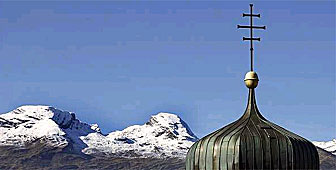Mountain people rediscover their roots

After 700 years of separation, the alpine people known as the Walsers are still proud of their common heritage.
“I was very impressed by the Walser reunion last year in Brig, in canton Valais,” explains Hubert Sele, mayor of the alpine village of Triesenberg in Liechtenstein.
“There were people there from Walser communities in Switzerland, Austria, Liechtenstein and Italy. The Walser anthem was sung and I somehow felt a certain solidarity with the other Walsers. I was touched by the experience.”
Triesenberg sits on a shelf above the Rhine, affording a wonderful view of the wide river valley. The Rhine is at its eastern most point here and serves as the border between the tiny principality of Liechtenstein and Switzerland.
After dark, the course of the river is marked by the headlights of a steady stream of cars moving north out of Switzerland’s interior.
13th century journey
Sele’s ancestors made the same journey – albeit more gruelling – in the 13th century from the upper Rhone Valley in what is now the Swiss canton of Valais.
These people were taking part in a large migration from the Rhone Valley, which saw families head east and south, following the promise of a better life.
Some settled in Eastern Switzerland – Davos is a Walser community. Others travelled to Liechtenstein, across the border in today’s Austria and in Northern Italy. To this day, they identify with being Walsers as much as they are Austrians, Swiss, Liechtenstein citizens or Italians.
“You have to be proud to be a Walser. It may be a little crass but in some ways we are a little different from people from other communities in Liechtenstein,” says Sele.
“The fact that we are a mountain folk certainly makes us different, but the biggest difference is our [German dialect],” he adds.
The accent is impossible to convey in words but there are certain pronunciation and grammar nuances unique to Walser German, and they change from Walser community to community.
“When someone from Triesenberg speaks, everyone knows where he comes from,” Sele says. “But you can’t tell the hometown of any other person from Liechtenstein just by the way they talk.”
The story is similar a couple hundred kilometres east in the Austrian alpine resort of Lech.
“You are confronted with the [Walser] culture if you come to Lech,” says Petra Malin, an archivist who is the first person attempting to write down the particular Walser dialect spoken in Lech.
“If you go into a local’s house, there are special chairs, and dishes and photographs. The house owners like to talk about their culture,” Malin says.
The fact that most alpine regions remained economically backward until the post-war period helped preserve Walser culture because there were few outside influences.
From farming to skiing
The culture was nearly destroyed once the modern world invaded, transforming many of the poor farming villages into ski resorts.
Paradoxically, the tourist boom has enabled the Walsers to prosper, preventing a mass exodus to towns in the valleys seen elsewhere in the Alps. This would have been the final nail in the coffin of Walser culture.
Instead, people with Walser ancestry are more curious than ever about their roots, and are trying to save what remains. The dialect is still being spoken, and proudly, even if the vocabulary once rich with words important for an agriculture-based society has been decimated.
Malin says the dialect is more popular than it was a few years ago, and it has become politically correct to speak it. “Our mayor only speaks in dialect. It’s the only thing I hear him speak.”
The tens of thousands of tourists who descend on Lech and Triesenberg each year are guests in hotels and restaurants named “Walser” and tour the Walser museums found in both villages.
“Languages, by their very nature, change over time,” says Josef Eberle, who runs the Walser museum in Triesenberg. “But it’s remarkable that our dialect has survived the centuries.
Alien language
“I can still remember from my school days when most people in the village spoke the dialect. There was someone from a different part of the country in my class and he spoke differently. It sounded almost alien.”
Eberle’s museum displays farm and household implements marked with the names in two languages – German and Walser German. He is hopeful Walser culture can be saved, despite the new threat of globalisation.
“The dialect has the potential to be considered an important cultural value, so that young people can feel they are special, and can identify with their community, with their language,” he says.
“There is a trend across Europe to recognise the importance of the individual regions. Not everything has to be seen from a global perspective. We are starting to recognise the cultural values of small communities.”
by Dale Bechtel

In compliance with the JTI standards
More: SWI swissinfo.ch certified by the Journalism Trust Initiative

You can find an overview of ongoing debates with our journalists here. Please join us!
If you want to start a conversation about a topic raised in this article or want to report factual errors, email us at english@swissinfo.ch.